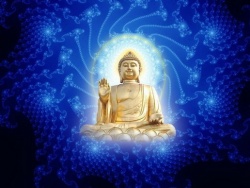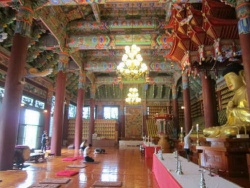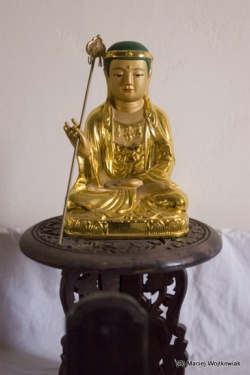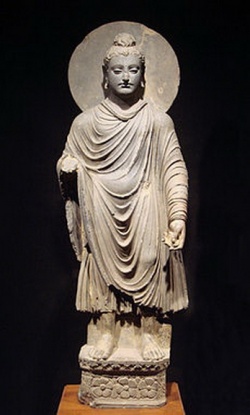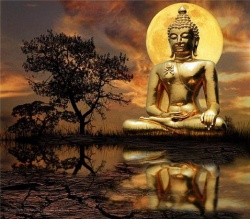Difference between revisions of "Dai-Gohonzon"
| Line 39: | Line 39: | ||
http://fraughtwithperil.com/rbeck/2006/01/21/the-taisekiji-daigohonzon-myth/ | http://fraughtwithperil.com/rbeck/2006/01/21/the-taisekiji-daigohonzon-myth/ | ||
[[Nichiren]] | [[Nichiren]] | ||
| − | [[Nichiren]] ([[日蓮]]) (February 16, 1222 – October 13, 1282), born [[Zennichimaro]] ([[善日麿]]), later [[Zeshō-bō Renchō]] ([[是聖房蓮長]]), and finally [[Nichiren]] ([[日蓮]]), was a [[Buddhist monk]] of 13th century [[Japan]] who inscribed His first [[Gohonzon]] during His exile to [[Sado]]. A controversial figure during his [[lifetime]], he is the founder of [[Nichiren Buddhism]], a major [[Japanese]] [[Buddhist stream encompassing several schools of often widely conflicting [[doctrine]]. | + | [[Nichiren]] ([[日蓮]]) (February 16, 1222 – October 13, 1282), born [[Zennichimaro]] ([[善日麿]]), later [[Zeshō-bō Renchō]] ([[是聖房蓮長]]), and finally [[Nichiren]] ([[日蓮]]), was a [[Buddhist monk]] of 13th century [[Japan]] who inscribed His first [[Gohonzon]] during His exile to [[Sado]]. A controversial figure during his [[lifetime]], he is the founder of [[Nichiren Buddhism]], a major [[Japanese]] [[Buddhist]] stream encompassing several schools of often widely conflicting [[doctrine]]. |
Note: This article deals with [[Nichiren's]] [[life]] from the {{Wiki|perspective}} of the [[Fuji Branch]], a collective [[name]] for the denominations (particularly [[Nichiren Shoshu]]) stemming from his [[disciple]] [[Nikkō]]. It describes [[Nichiren's]] inscription of the [[Dai-Gohonzon]], a unique [[Gohonzon]] the [[Fuji Branch]] schools purport he inscribed as described below. Non-Fuji branches of [[Nichiren]] [[Buddhism]] dispute this {{Wiki|history}} as well as the legitimacy of the [[Dai-Gohonzon]], asserting that its inscription by [[Nichiren]] is not substantiated by documentary {{Wiki|evidence}} attributable to him. | Note: This article deals with [[Nichiren's]] [[life]] from the {{Wiki|perspective}} of the [[Fuji Branch]], a collective [[name]] for the denominations (particularly [[Nichiren Shoshu]]) stemming from his [[disciple]] [[Nikkō]]. It describes [[Nichiren's]] inscription of the [[Dai-Gohonzon]], a unique [[Gohonzon]] the [[Fuji Branch]] schools purport he inscribed as described below. Non-Fuji branches of [[Nichiren]] [[Buddhism]] dispute this {{Wiki|history}} as well as the legitimacy of the [[Dai-Gohonzon]], asserting that its inscription by [[Nichiren]] is not substantiated by documentary {{Wiki|evidence}} attributable to him. | ||
Revision as of 16:05, 26 September 2013
Dai-Gohonzon
大御本尊 ( Jpn)
The object of devotion that Nichiren inscribed at Minobu, Japan, on the twelfth day of the tenth month in 1279, and which he referred to as the purpose of his advent. "Dai-Gohonzon" literally means the great object of devotion.In On Persecutions Befalling the Sage, written on the first day of the same month, Nichiren states: "Now, in the second year of Koan (1279), cyclical sign tsuchinoto-u, it has been twenty-seven years since I first proclaimed this teaching at Seicho-ji temple. It was at the hour of the horse [noon] on the twenty-eighth day of the fourth month in the fifth year of Kencho(1253), cyclical sign mizunoto-ushi, on the southern side of the image hall in the Shobutsu-boof Seicho-ji temple... The Buddha fulfilled the purpose of his advent in a little over forty years, the Great Teacher T'ient'ai took about thirty years, and the Great Teacher Dengyo, some twenty years. I have spoken repeatedly of the indescribable persecutions they suffered during those years. For me it took twenty-seven years, and the great persecutions I faced during this period are well known to you all" (996).The Dai-Gohonzon was entrusted to Nikko, and then to Nichimoku, and preserved at Taiseki-ji temple. Matters to Be Observed after Nikko's Death, a document of entrustment from Nikkoto Nichimoku, reads: "As for the Dai-Gohonzon of the second year of Koan [1279] that was entrusted to my person, I bestow it on Nichimoku." Nichiren inscribed the Dai-Gohonzon during the time of the Atsuhara Persecution. Twenty farmers were arrested and pressured with threats to disavow their belief in Nichiren's teachings, but all refused to do so. Three were then beheaded. It is said that Nichiren inscribed the Dai-Gohonzon in response to the sincere and courageous faith of these ordinary believers.
See also; Gohonzon; Three Great Secret Laws.
The Dai Gohonzon, a mandala inscribed with Sanskrit and Chinese characters on a plank of Japanese camphorwood, is the object of veneration for Nichiren Shoshu and Soka Gakkai; Dai means "great" or "supreme," whereas gohonzon means "object of devotion." The mandala chiefly comprises the names of numerous buddhas, bodhisattvas, Buddhist deities, and Buddhist teachers around the characters Namu Myoho Renge Kyo Nichiren written down the middle. The Dai-Gohonzon is housed at Nichiren Shoshu's head temple, Taiseki-ji.
Overview of the Dai-Gohonzon
The Gohonzon is the Object of Devotion in Nichiren Buddhism. Nichiren inscribed the first Gohonzon during His Exile to Sado. Nichiren Shoshu, and also Soka Gakkai, believe that Nichiren inscribed the Dai-Gohonzon on the twelfth day of the tenth month, 1279. Nichiren Shoshu and Soka Gakkai believe a passage in Nichiren's 'On Persecutions Befalling the Sage' proves the authenticity of the Dai-Gohonzon. The passage reads:
"The Buddha fulfilled the purpose of his advent in a little over forty years, the Great Teacher T'ient'ai took about thirty years, and the Great Teacher Dengyo, some twenty years. I have spoken repeatedly of the indescribable persecutions they suffered during those years. For me it took twenty-seven years, and the great persecutions I faced during this period are well known to you all."
Other than Nichiren ShoShu sect of Buddhism, other schools including the Soka Gakkai, Nichiren Shu and Kempon Hokke do not believe that the Dai-Gohonzon is superior to other Gohonzons. According to SGI teachings, home enshrined Gohonzon is equal in its significance and spiritual value as the Dai-Gohonzon. SGI state:
"The Gohonzon enshrined at our home carries the same significance as the Dai- Gohonzon. They are as beneficial as the Dai-Gohonzon, in accord with the Buddhist principle of 'dispersing the body of the original in different forms' (Jpn funjin santai )."
According to SGI teachings, the power of the Object of Devotion is not found in an external mandala, but through one's inner faith:
"First, the power of any Gohonzon, including the Dai-Gohonzon, can be tapped only through the power of faith. In other words, we should be clear that it is wrong to think that the Dai-Gohonzon alone has some kind of unique mystic power that no other Gohonzon possesses. The Dai-Gohonzon and our own Gohonzon are equal".
Questions about the Dai Gohonzon
Among Nichiren Buddhists, there are two perspectives for viewing the authenticity of the Dai-Gohonzon. The main doubt about the authenticity of the Dai-Gohonzon centers on the argument that there is no available letter from Nichiren, in which he declared that he inscribed the Dai-Gohonzon. It is notable also to mention that there is no disputed or forged letter either, which would have falsely attributed the inscription of the Dai-Gohonzon to Nichiren.
In addition to the argument about a letter for confirming the validity of the Dai-Gohonzon – there are other issues, which arguments are found in the following two links, each carrying an opposite message about the subject:
Questions and Answers about the Dai-Gohonzon:
http://www.gakkaionline.net/Dai-Gohonzon/index.html
The Taisekiji Dai-Gohonzon Myth:
http://fraughtwithperil.com/rbeck/2006/01/21/the-taisekiji-daigohonzon-myth/
Nichiren
Nichiren (日蓮) (February 16, 1222 – October 13, 1282), born Zennichimaro (善日麿), later Zeshō-bō Renchō (是聖房蓮長), and finally Nichiren (日蓮), was a Buddhist monk of 13th century Japan who inscribed His first Gohonzon during His exile to Sado. A controversial figure during his lifetime, he is the founder of Nichiren Buddhism, a major Japanese Buddhist stream encompassing several schools of often widely conflicting doctrine.
Note: This article deals with Nichiren's life from the perspective of the Fuji Branch, a collective name for the denominations (particularly Nichiren Shoshu) stemming from his disciple Nikkō. It describes Nichiren's inscription of the Dai-Gohonzon, a unique Gohonzon the Fuji Branch schools purport he inscribed as described below. Non-Fuji branches of Nichiren Buddhism dispute this history as well as the legitimacy of the Dai-Gohonzon, asserting that its inscription by Nichiren is not substantiated by documentary evidence attributable to him.
In the autumn of 1279, a number of Nichiren's lay believers in the Fuji District came into the crosshairs of Gyōchi (行智), the chief priest of a temple where Nisshū (日秀), one of Nichiren's disciples, lived. The believers, uneducated peasant farmers from the village of Atsuhara, had come to help Nisshū with the harvest of his private rice crop. Gyōchi saw this as his chance to get rid of a thorn in his side and called some local warriors to arrest the peasants, accusing them of illegally harvesting the rice. The peasants decided to defend themselves when the warriors arrived but were no match, and several were wounded; twenty were arrested and hauled off to Kamakura for trial.
When they arrived, Hei no Saemon was waiting for them; but his true purpose seemed to lie more in persecuting than prosecuting, since he attempted to intimidate the peasants into renouncing their faith—on pain of death if they didn't but in exchange for their freedom if they did. Yet despite repeated threats and even torture, they remained steadfast. Hei no Saemon even had three beheaded, but the other 17 refused to back down and he eventually freed them. These events took place on October 15, 1279.
In the Nichiren Shoshu tradition (other schools vary in their interpretation of this event's significance or dispute the claim that it occurred) Nichiren, observing from his disciples' reports that his followers were ready to sacrifice themselves in the name of their faith, decided that the time was ripe for him to "reveal" the Gohonzon that he intended to fulfill the purpose his advent in this world (出世の本懐: shusse no honkai). On October 12, 1279, he inscribed the Gohonzon known as the Dai-Gohonzon, which – in contrast to other Gohonzon inscribed in this period – was intended for worship by all his disciples and believers, contemporary and future, rather than just the specific individual named on it.
Another Dai Mandala
In addition to Nichiren ShoShu school, the Fujisan Honmon ShoShu school also claim possession of a Nichiren inscribed Dai Gohonzon called The "Dai Honzon". The Dai Honzon is the Object of Devotion of Fujisan school and it is enshrined at Hota Myohonji Temple. This dai mandala carries the description of “The Great Object of Worship to Save and Protect for Ten Thousand Years." and carries a signature of “Jogyo Nichiren “. http://nichirenscoffeehouse.net/GohonzonShu/016.html
Source
Wikipedia:Dai-Gohonzon
As for the authenticity of the Dai Honzon, there is no mention of arguments among any of Nichiren schools which would question its validity. Both the Dai Gohonzon at Taisekiji and the Dai Honzon at Hota Myohonji were not mentioned in available Nichiren letters.
